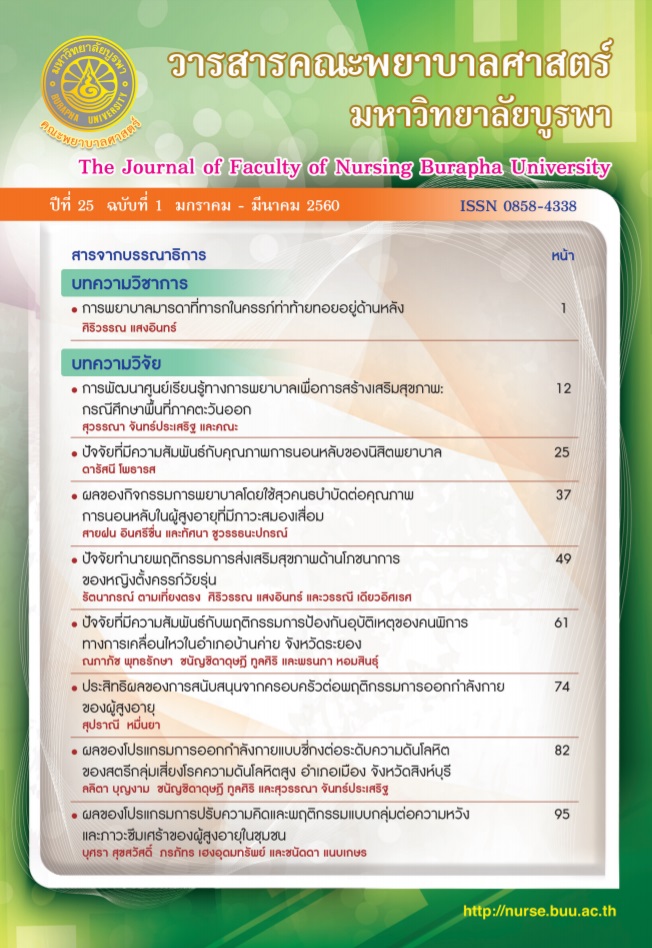ผลของโปรแกรมการออกกำลังกายแบบชี่กงต่อระดับความดันโลหิตของสตรี กลุ่มเสี่ยงโรคความดันโลหิตสูง อำเภอเมือง จังหวัดสิงห์บุรี*
คำสำคัญ:
โปรแกรมการออกกำลังกายแบบชี่กง, ระดับความดันโลหิต, สตรีกลุ่มเสี่ยงโรคความดันโลหิตสูง, The qigong exercise program, blood pressure levels, prehypertensive womenบทคัดย่อ
การศึกษาครั้งนี้มีวัตถุประสงค์เพื่อศึกษาผลของโปรแกรมการออกกำลังกายแบบชี่กงต่อระดับความดันโลหิตของสตรีกลุ่มเสี่ยงโรคความดันโลหิตสูง อำเภอเมือง จังหวัดสิงห์บุรี กลุ่มตัวอย่างได้แก่ สตรีกลุ่มเสี่ยงโรคความดันโลหิตสูงจำนวน 60 คน ซึ่งได้มาจากการสุ่มแบบหลายขั้นตอน แบ่งเป็นกลุ่มทดลองและกลุ่มควบคุม กลุ่มละ 30 คน โดยกลุ่มทดลองได้รับโปรแกรมการออกกำลังกายแบบชี่กง ระยะเวลา 8 สัปดาห์ ทุกวันจันทร์-วันพฤหัสบดี ครั้งละ 60 นาที ส่วนกลุ่มควบคุมได้รับความรู้ในการปฏิบัติตัวตามปกติ ประเมินระดับความดันโลหิตหลังสิ้นสุดการทดลอง 1 สัปดาห์ เครื่องมือที่ใช้ในการทดลองประกอบด้วยโปรแกรมการออกกำลังกายแบบชี่กง คู่มือการออกกำลังกายแบบชี่กง และเครื่องวัดความดันโลหิตแบบสอดแขน เครื่องมือที่ใช้ในการเก็บรวบรวมข้อมูลประกอบด้วยแบบสอบถามข้อมูลส่วนบุคคล แบบสอบถามพฤติกรรมการออกกำลังกายแบบชี่กง ซึ่งมีค่าสัมประสิทธิ์อัลฟ่าของครอนบาคเท่ากับ .83 และแบบบันทึกระดับความดันโลหิต วิเคราะห์ข้อมูลโดยใช้สถิติพรรณนา และการวิเคราะห์ความแปรปรวนร่วม
ผลการวิจัยพบว่าภายหลังการทดลอง กลุ่มทดลองมีค่าเฉลี่ยคะแนนพฤติกรรมอยู่ในระดับดี (M = 2.88, SD = 0.24) และเมื่อควบคุมอิทธิพลของระดับความดันโลหิตซีสโตลิคและไดแอสโตลิค ก่อนการทดลองกลุ่มทดลองมีค่าเฉลี่ยระดับความดันโลหิตซีสโตลิคและไดแอสโตลิคต่ำกว่ากลุ่มควบคุมอย่างมีนัยสำคัญทางสถิติ (F(1, 57) = 196.03, p < .001; F(1, 57) = 67.36, p < .001 ตามลำดับ) จากผลการวิจัยมีข้อเสนอแนะว่า พยาบาลที่ปฏิบัติงานในหน่วยบริการระดับปฐมภูมิสามารถนำรูปแบบการออกกำลังกายแบบชี่กงไปประยุกต์ใช้กับกลุ่มเสี่ยงโรคความดันโลหิตสูงในชุมชน เพื่อควบคุมป้องกัน การเกิดโรคความดันโลหิตสูงและลดจำนวนผู้ป่วยโรคความดันโลหิตสูงรายใหม่ต่อไป
The purpose of this research was to examine the effects of the qigong exercise program on blood pressure levels among prehypertensive women in Meuang district, Sing Buri province. A multistage random sampling method was used to recruit 60 women who were at risk of hypertension and who met the inclusion criteria. Then they were randomly assigned into either the experimental (n = 30) or the control (n = 30). The experimental group received the qigong exercise program for 8 weeks, Monday-Thursday for 60 minutes per day, whereas the control group received a routine service from the hospital. Blood pressure level was measured one week after end of the experiment. Research experimental instruments included the qigong exercise program, handbook for the qigong exercise program and. arm blood sphygmomanometers. Data was collected by demographic questionnaires and questionnaires to measure qigong exercise behavior with Cronbach’s alpha coefficient of .83 and a blood pressure record form. Data was analyzed by using descriptive statistics and analysis of covariance (ANCOVA).
The results revealed that after experiment, the experimental group had mean scores of qigong exercise behavior at good levels (M = 2.88, SD = 0.24). The experimental group had lower adjusted means scores of systolic and diastolic blood pressure than those of the control group at the significance (F(1, 57) = 196.03, p < .001; F(1, 57) = 67.36, p < .001 respectively). The findings suggest that nurses and other health professions can use this qigong exercise program among people at risk of hypertension in the community in order to prevent hypertension, which consequently leads to decreases in a number of hypertension patients.





